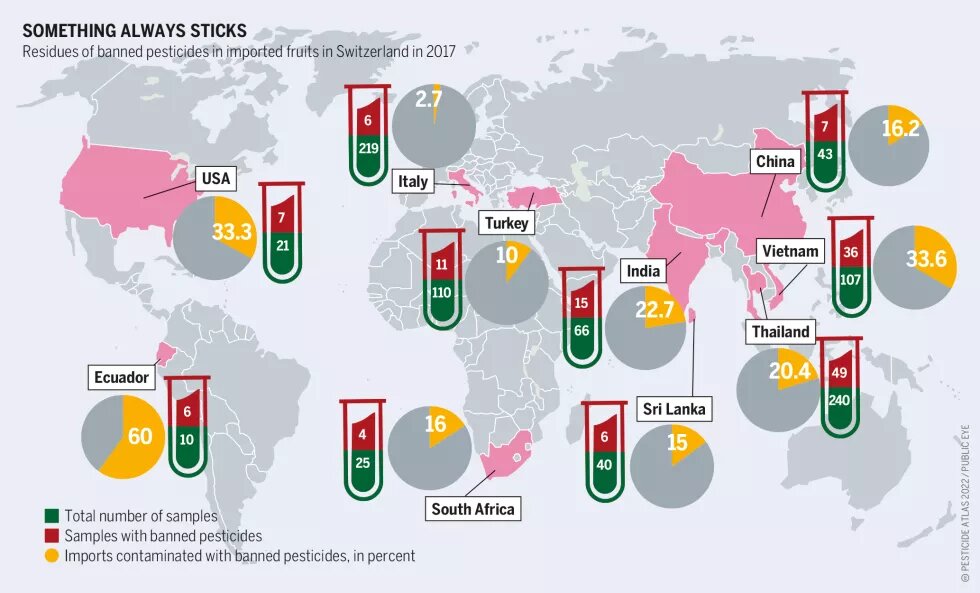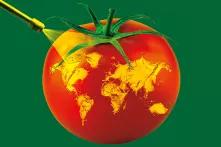
Pesticide use leads to residues in food to which many people are exposed – especially in the Global South. But as an import, contaminated food can also end up on European plates.

Chemical residues can be problematic to both wildlife and humans. The daily intake of pesticide-contaminated food can pose severe health risks. Sensitive groups such as pregnant women or children are particularly at risk. To protect consumers from residues in food, governments are taking regulatory action. This legislation generally provides for the limitation of residue levels that may be allowed in food items entering or leaving various countries. These maximum residue levels (MRLs) are set almost everywhere in the world. Since 1963, the United Nations publish the Codex Alimentarius, a collection of standards for food safety and product quality. The maximum residue levels contained therein are considered an important international reference. Nonetheless, there are big differences in the maximum legal intake quantity of pesticide residues depending on the country and region.
For each approved active ingredient the European Union specifies the maximum concentration of a pesticide residues to be legally permitted in various food. If goods exceed the limits, they may not be placed on the European market.
EU maximum residue levels are based on the cultivation practices, the toxicity of the active ingredient, and food consumption. Baby food must meet stricter specifications.
The European Food Safety Authority (EFSA) publishes annual reports on food commodities that are tested on the basis of random samples: In 2019, 3.9 percent of all samples exceeded the limits. Just over half of the food checked was free of detectable contamination, whereas 27 percent contained two or more pesticide residues. Multiple residues were found particularly in fresh products, such as black currants, sweet cherries, grapefruits, rocket, and table grapes. A sample of raisins headed the list of most-contaminated food – the EFSA detected twenty-eight different pesticides.
Health experts criticize the absence of maximum legal limits for multiple residues in food. A further criticism is that companies can circumvent regulations. If active ingredients lose their EU approval for example because they are classified as carcinogenic their maximum residue level is automatically lowered to protect human health. Usually, the limit is lowered to 0.01 milligrams per kilogram, which also applies for imported goods. To avoid this, pesticide manufacturers who have to fear a ban of one of their active ingredients for health reasons often just let EU permits expire. Without a formal denial of approval for health reasons they can apply for “import tolerance”: A higher MRL set for imported products to meet the needs of international trade. EU law forbids granting this for pesticides that have lost their approval because of health effects.
The EU has a tighter regulation than many non-EU countries. In Japan, for example, almonds may be contaminated with one milligram glyphosate per kilogram – which is ten times as much as the EU permits. In tomatoes, Japan allows two micrograms imidacloprid per kilogram. This is four times the residue level currently possible in the EU. In the Eastern Mediterranean, an area that is home to nearly 680 million people and includes countries from the Middle East to Cen tral Asia, maximum residue levels have been exceeded in up to 61 percent of food samples over the past 15 years. Repeatedly, residues of globally long banned pesticides are detected there. Brazil is another example for a lack of efficient regulation that imposes on its population maximum residue levels in food that are two or three times higher than the maximum residue levels in the EU in some cases and even hundreds of times higher in other cases. According to the official Brazilian residue report, in 2019, 23 percent of all samples exceeded even the already high national maximum residue levels. EU-banned active ingredients have also been detected as residues in Brazilian cereals, fruits and vegetables. As export goods, these pesticide residues end up again in Europe or other regions. Put differently: A pesticide which is forbidden in Europe can be exported to a third country, used on crops, and then imported back as a residue onto European plates.
In Kenya in 2020, a total of 25 different active ingredients were found in tomato and kale samples – 51 percent of the detected active ingredients were already withdrawn from circulation in the EU long ago. Of the total of 25 samples, 60 percent exceeded the maximum residue levels. It is alarming in particular, because these two vegetables are part of the staple foods of Kenyan population. In Nigeria, elevated levels of residues were also detected in tomato samples, including traces of permethrin. The US Environmental Protection Agency (EPA) classified this insecticide as “probably carcinogenic”. In the last years, beans from Nigeria showed high levels of contamination. The samples contained up to 0.3 milligrams per kilogram of dichlorvos; the legal limit in Europe is 0.01 milligrams per kilogram. Dichlorvos can cause difficulties breathing, diarrhoea, and vomiting among other effects. The EU has reacted and issued an import ban on beans from Nigeria. Timely and sufficient support for non-chemical plant protection practices can prevent such exclusions from the EU market.

